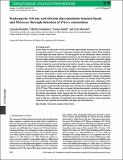Por favor, use este identificador para citar o enlazar a este item:
http://hdl.handle.net/10261/93549COMPARTIR / EXPORTAR:
 SHARE SHARE
 CORE
BASE CORE
BASE
|
|
| Visualizar otros formatos: MARC | Dublin Core | RDF | ORE | MODS | METS | DIDL | DATACITE | |

| Título: | Studying the 410-km and 660-km discontinuities beneath spain and morocco through detection of p-to-s conversions |
Autor: | Bonatto, Luciana CSIC ORCID; Schimmel, Martin CSIC ORCID ; Gallart Muset, Josep CSIC ORCID; Morales, José | Palabras clave: | Time-series analysis Body waves |
Fecha de publicación: | 2013 | Editor: | Oxford University Press | Citación: | Geophysical Journal International 194: 920- 935 (2013) | Resumen: | In this study, we analyse the 410-km and 660-km upper-mantle transition zone discontinuitiesas seen from seismic P-to-s wave conversions beneath the Eurasian-African Plate boundaryat south Spain and north Morocco. For this purpose we use teleseismic events recorded at43 broad-band seismic stations deployed mainly by the TopoIberia project. The conversionsfrom the upper-mantle discontinuities arrive in the P-wave coda together with other signalsand are usually identified on stacked receiver functions. We build a new processing approachwhich is leaned on receiver functions and which is based on cross-correlation and stackingtechniques to efficiently detect and extract signals by means of their coherence, slowness, traveltime and polarity. In order to add consistency and robustness to the detections, our finalresults are based on a joint analysis of two different cross-correlation functionals and receiverfunctions. This permits to assess errors and to bridge observation gaps due to the breakdownof any of the techniques inherent to signal and noise characteristics. Finally, discontinuitydepths are determined using time corrections obtained from a 3-D velocity model. We presenttopography maps for the 410-km and 660-km discontinuities which show a thickening of thetransition zone beneath the plate boundary towards Morocco. The transition zone thickness isabout global average beneath south Spain (240-250 km) and is thicker beneath east Morocco(250-275 km). This is mainly due to a deeper 660-km discontinuity, while the topography ofthe 410-km discontinuity is smaller. In the Alboran Sea we find an up to 25 km deflection ofthe 660-km discontinuity which suggests that the Alboran Sea heterogeneity or slab is stillsufficiently cold to depress the post-spinel phase transition. We finally discuss the results inorder to add new constraints on temperature and composition to seismic velocity anomaliesobserved in the transition zone beneath south Spain and north Morocco.© The Authors 2013. | Versión del editor: | http://dx.doi.org/10.1093/gji/ggt129 | URI: | http://hdl.handle.net/10261/93549 | DOI: | 10.1093/gji/ggt129 | Identificadores: | doi: 10.1093/gji/ggt129 issn: 0956-540X |
| Aparece en las colecciones: | (Geo3Bcn) Artículos |
Ficheros en este ítem:
| Fichero | Descripción | Tamaño | Formato | |
|---|---|---|---|---|
| Bonatto 2013 Geophys J Int 920 35.pdf | 4,97 MB | Adobe PDF |  Visualizar/Abrir |
CORE Recommender
SCOPUSTM
Citations
10
checked on 09-abr-2024
WEB OF SCIENCETM
Citations
10
checked on 22-feb-2024
Page view(s)
435
checked on 18-abr-2024
Download(s)
272
checked on 18-abr-2024
Google ScholarTM
Check
Altmetric
Altmetric
NOTA: Los ítems de Digital.CSIC están protegidos por copyright, con todos los derechos reservados, a menos que se indique lo contrario.
